Thunder Token Review: Complete Beginners Guide to ThunderCore
ThunderCore is one of the latest projects that is trying to solve the blockchain trilemma. That constant struggle between Decentralization, Scalability and Security.
The project is the culmination of years of scientific research. It was only launched recently and has already started achieving interesting results. Trading volumes in the Native Thunder Token has also picked up at a rapid pace.
However, can the project really achieve these ends?
In this ThunderCore review I will attempt to answer that. I will also analyse the long term use cases and adoption potential of the Thunder Tokens.
ThunderCore Solution
As mentioned, the blockchain Trilemma is a pertinent one. Quite simply, it is the notion that any blockchain technology is only able to achieve two of the three following traits at the same time:
- Decentralization
- Scalability
- Security
The most famous proponent of this idea is Ethereum’s founder Vitalik Buterin. However, the ThunderCore protocol offers an elegant solution to the problem and believes it has found a way to deliver all three traits at the same time.
It will solve the problem by combining a standard blockchain, which they are calling the “slow chain” and such as you would find on Bitcoin, Ethereum or any other Proof-of-Work chain, with another chain they are calling the “fast path.”
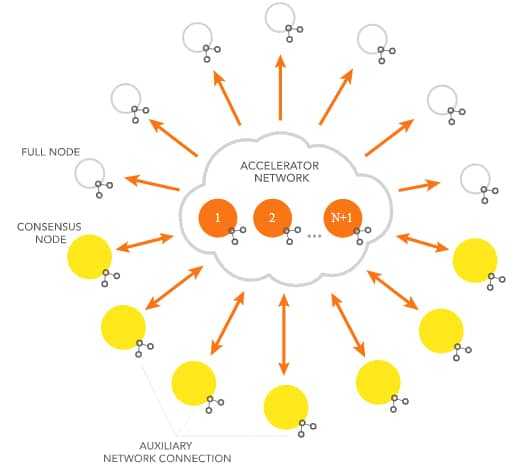
The fast path is a Proof-of-Stake chain that is secured by a committee of 300 stakeholders and is coordinated by the central authority called the “Accelerator.” The Accelerator exists to linearize transactions and data on the fast chain and was created as a simple way to accomplish this task, which is quite difficult to do in a decentralized fashion.
By combining the slow chain and fast path in this manner ThunderCore achieves the following blockchain behavior:
- When the network is working properly i.e. not under attack or compromised, it supports instant confirmations and high throughput.
- If the network does come under attack the blockchain security is maintained as long as the slow chain remains secure and as long as a majority of the stakeholders remain honest. This is true even if the Accelerator is corrupted and acting maliciously.
ThunderCore was built and developed with the application developer community in mind. Not only was it built around developer needs, but it also collects data, feedback, and insights on how the platform is being used by developers to create decentralized applications.
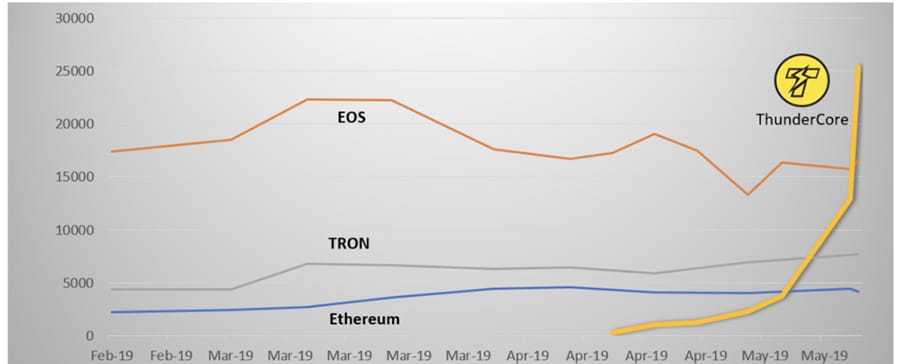
This data is then used to ensure the platform best supports the developer community. One of these supports is that Ethereum dApps can be ported to ThunderCore in under five minutes.
ThunderCore Roadmap and Growth
The ThunderCore development team spent six months analyzing the data from their testnet and cleaning up bugs in the code before launching a Pre-Release mainnet on February 28, 2019. The Pre-Release Mainnet was only different from a Public Mainnet in that TT tokens could not be staked on the Pre-Release Mainnet.
The number of addresses and transactions seen on the Pre-Release Mainnet was significant, with the total number of addresses growing to more than 40,000 by the end of April 2019, and the number of transactions climbing to nearly 200,000.
On May 14, 2019, the ThunderCore team announced the launch of the official mainnet, which came following the ICO on May 9. Because of the full compatibility ThunderCore has with the Ethereum Virtual Machine dApps can be quickly and easily migrated to the mainnet.
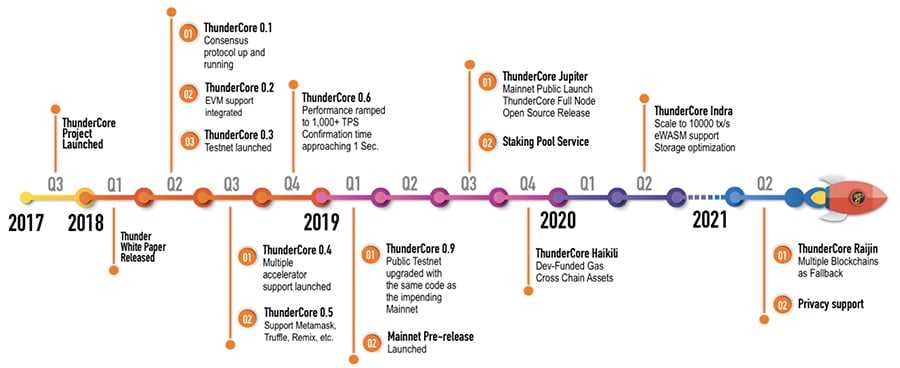
Now that the mainnet has officially launched the ThunderCore development team will focus on three key areas of the protocol:
- Research and Design of the Protocol
- Blockchain Implementation
- Developer and User Enhancements
The first area of focus has mostly been completed at this time, with the mainnet launch and the implementation of the Proof-of-Stake incentives. This is bringing about large-scale consensus and committee elections.
The third area of focus is also nearly complete for the time being, with the team looking to add portal enhancements for developers. This is expected to be completed sometime in the third quarter of 2019.
The largest changes in the second half of 2019 will be made in the area of Blockchain Implementation. This will see the next release of ThunderCore called Haikili released sometime in the fourth quarter of 2019, and will bring developer funded gas and cross chain assets to ThunderCore.
The final scheduled upgrades on the roadmap are increased privacy support and the ThunderCore Raijin release, which will add additional blockchains to the protocol as fallback measures. These changes aren’t expected until the second quarter of 2021.
The ThunderCore Team
The ThunderCore team is global, but the majority of the more than 60 team members are located in San Francisco, CA. The core team of ThunderCore consists of highly dedicated blockchain professionals, all of whom have solid experience in blockchain, networking, security, software development and other areas of computer science.
The primary leaders of the team are CEO Chris Wang, co-founder Elaine Shi and co-founder Rafael Pass.
Chris Wang, the CEO of ThunderCore, received his Ph.D. in Computer Science from Carnegie Mellon when he was just 22 years old. He went on to become a co-founder of the gaming company Playdom, which was acquired by Disney in 2010 for $532 million, although it was later shut down.
Elaine Shi is the Chief Scientist at ThunderCore and is one of the co-founders of the project. She also received her Ph.D. in Computer Science from Carnegie Mellon, and in addition to co-founding ThunderCore, she is also a co-founder of the Initiative for Cryptocurrency and Contracts (IC3).

She is extremely experienced in the blockchain space and can be considered a pioneer as she was the first person to write an academic paper concerning Bitcoin and decentralized smart contracts. She has received numerous awards for her work and was the author of the Thunderella protocol, which became the basis for the ThunderCore protocol.
The other co-founder of ThunderCore is Rafael Pass, who received his Ph.D. in Computer Science from the Swedish Royal Institute of Technology. He also received an additional Ph.D. in Computer Science from MIT, and he currently works as a professor at Cornell University.
Pass is considered to be an expert on cryptographic protocols, consensus, and game theory. He was also a co-founder of IC3 alongside Professor Shi, and he helped create the highly scalable ANONIZE computation protocol implemented in the Brave browser with Abhi Shelat.
ThunderCore Partnerships
I normally don’t mention partnerships because in many cases in the blockchain space partnerships are not very meaningful, often created between two blockchain companies neither of which have a viable product. This is not true in the case of ThunderCore and its partners, all of which are already leaders in the blockchain space with solid products.
The first of these partnerships is with TrustWallet, the official cryptocurrency wallet of the Binance Exchange, which now supports the TT token as well. The wallet will also give users access to all the dApps built on the ThunderCore platform.

A second critical partnership has been formed with BlockVigil, who will give ThunderCore advanced integration capability by delivering a transparent API layer to users.
In order to ensure dApp vulnerabilities and protect developers and users, a partnership with Silicon Valley-based blockchain security firm AnChain.ai was formed. The technology developed by AnChain.ai will help determine if the dApps on the ThunderCore platform are safe to interact with.
Last, but not least, is the partnership formed with Liquidity Network, who will be launching their NOCUST payment hub on ThunderCore’s blockchain.
ThunderCore Community
When it comes to increasing adoption and awareness of a cryptocurrency, the community behind said project can be powerful. Hence, I decided to get a better look at the size and engagement of community behind the ThunderCore project.
Firstly, it is important to point out that this project really is global in scope. They have three Telegram channels to support three of their most popular languages.
In the English Telegram channel, they have over 4,900 members. Their Korean channel is on the lighter side with 445 members but they have over 21,000 members in their Chinese channel!
I decided to jump into their English channel to get a better sense of the discussion that was taking place there.
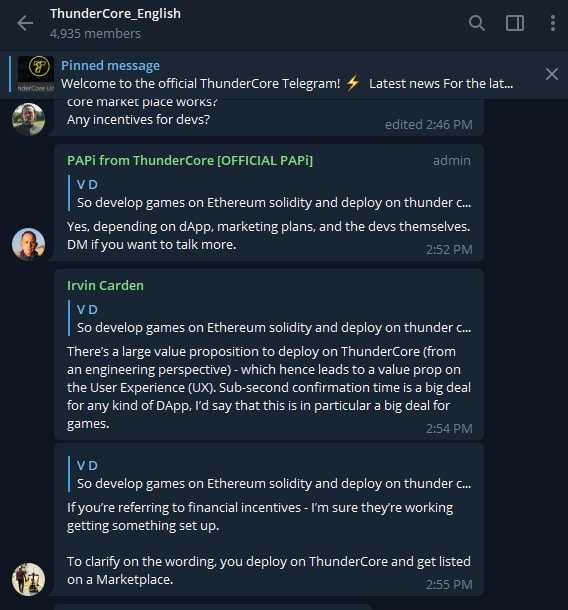
As you can see, the Admins are being quite helpful with those new to the channel and community. There was a bit of price banter and memes that were shared amoung the community but this is normal for most crypto telegram channels.
Taking a look at some other social channels, ThunderCore has a pretty active Twitter account that has just below 10k followers. This is less than we have seen on other official project accounts.
Finally, they also have a Reddit, Discord and official blog. The latter is perhaps one of the best ways to get important updates from the ThunderCore team.
The TT Token
The TT Token is an ERC-20 token for the ThunderCore blockchain. It acts as a store of value and provides the gas for transaction fees on the blockchain and to underwrite the smart contracts that are created on the ThunderCore blockchain.
It will also be used to build and monetize dApps on ThunderCore. Finally, it can be staked in order to become one of the committee stakeholders or to become the Accelerator and receive incentives for securing the network and processing transactions.
ThunderCore first raised $50 million in private equity during three rounds of private investment. On May 9, 2019, they held an IEO on Huobi Prime Lite, raising $500,000 and selling tokens at $0.015 each.
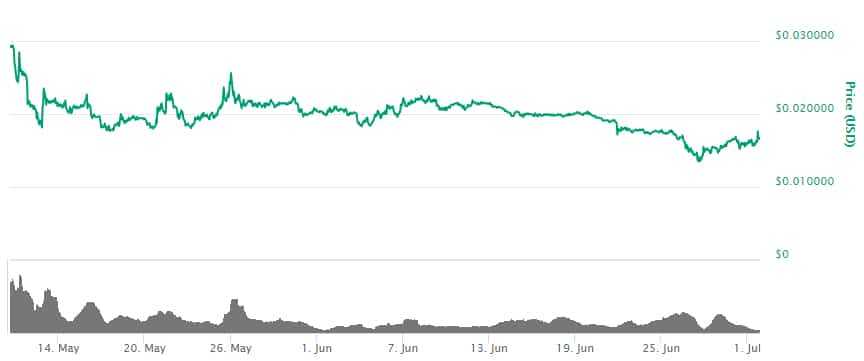
Given the very short time the token has been in existence its notable that it is currently in the 122 position on CoinMarketCap with a market capitalization of just over $46.5 million.
After its release on May 10, 2019, the TT token immediately jumped higher, hitting its all-time high of $0.02818 on its first day of trading. It dropped quickly and spent the next several weeks trading between the $0.02 and $0.025 level.
By the end of June, it dipped below the $0.02 level however and hit its all-time low of $0.013012 on June 27, 2019. At the time of writing (July 1, 2019) the token is trading at $0.016044.
Buying & Storing Thunder Tokens
Given that the Thunder Token was issued in an IEO that took place on the Huobi Exchange, (now HTX), it only makes sense that this would have the most trading volume. However, there is reasonable amounts of volume on exchanges such as Hotbit and Upbit.
What was surprising to me was that the token is not yet listed on Binance. TrustWallet is owned by Binance and they have already started offering support Thunder Token so it looks like a natural fit.
Irrespective of this though, there appears to be decent trading turnover for the Thunder Tokens on the exchanges where they are listed. This means that liquidity should not be an issue when executing large block orders.

When you have bought your Thunder Token then you will want to take them off of the exchanges. This is no doubt one of the most prudent things to do given the numerous examples of large exchange hacks.
Given that ThunderCore was built on top of the Ethereum Blockchain, you can store the tokens in any ERC20 compatible wallet. However, you are perhaps best suited to use a secure offline alternative like a hardware wallet.
Having said this, the ThunderCore team is working with other wallet developers to add support for Thunder Token.
Conclusion
The ThunderCore project is an interesting take on smart contracts and dApp creation with a goal of improving blockchain technology across the board. The team behind the project is an impressive one, and the adherence to their own timeline is notable. Now that the public mainnet has launched we can see how well ThunderCore stacks up against its competitors.
The first 10 weeks saw ThunderCore attract 10,000 active users to its platform. The speed of user acquisition was far faster than similar platforms, although that might be due to the maturing dApp communities. We will have to wait and see if growth continues at that pace.
One concern for the project comes in connection with their recent IEO. The price of that IEO was far below the price at the private funding rounds, which were $0.01 in the first round, $0.02 in the second round, and $0.10 in the final round of private funding.
It’s an unwritten rule that the large investors who buy in these private funding rounds are supposed to get the best price for tokens, but ThunderCore has undercut private investors by 85% in their public sale. That could create problems long term, especially if the project intends on securing additional funding.
Business concerns aside, the technical team is a strong one, and they seem to have a good grasp on what they need to do to accomplish their goal of scalability, security, and decentralization in a blockchain.
Disclaimer: These are the writer’s opinions and should not be considered investment advice. Readers should do their own research.
